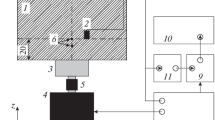Abstract
For the determination of the subcutaneous fat layer ultrasonic measurements were used in the examination of 1200 healthy children aged 3–14 years. The reproducibility of the method, the influence of the thickness of the fat layer on the results, and the sites to be measured were examined.
Under certain conditions, the ultrasonic method yields more exact results. As opposed to the caliper method, the reproducibility is independent of the thickness of the fat layer. Only the single fat-layer thickness is measured by the ultrasonic method. The results are not influenced by compression of the layer. The reproducibility of the sum of three measurements at the triceps-, the subscapular-, and the suprailiacal site of measurement is better than the reproducibility of any single measurement.
One disadvantage of the ultrasonic method is the longer training period necessary. Only after gaining experience is one able to interprete the marks on the screen properly. For this reason the ultrasonic instrument will be of better use for larger clinics and institutes than for the medical practitioner.
For comparison with data obtained by the caliper method means and standard deviations of the results obtained at the different sites are given for age and sex.
Zusammenfassung
Zur Bestimmung der subcutanen Fettgewebsdicke wurde als neues Meßverfahren die Ultraschallmessung in einer Reihenuntersuchung eingesetzt. An insgesamt 1200 gesunden Kindern (3–14 Jahre) wurden die Reproduzierbarkeit, der Einfluß der Fettgewebsdicke auf die Meßergebnisse und die Auswahl der Meßpunkte für die Ultraschallmethode untersucht.
Es zeigt sich, daß die Ultraschallmessung unter bestimmten Bedingungen, verglichen mit der Harpenden-Caliper-Messung, die exakteren Ergebnisse liefert. Die Reproduzierbarkeit der Ultraschallmessung wird nicht durch die Dicke der subcutanen Fettgewebsschicht beeinflußt. Die Abweichung von Doppel- und Wiederholungsmessungen durch denselben oder verschiedene Untersucher beträgt 5–8%. Ein Nachteil der Ultraschallmethode ist die Notwendigkeit einer bedeutend längeren Einarbeitungszeit.
Zu Vergleichszwecken werden die Mittelwerte und Standardabweichungen der subcutanen Fettgewebsdicke der untersuchten Kinder getrennt nach Alter und Geschlecht angegeben.
Similar content being viewed by others
Literatur
Björntorp, P., Sjöström, L.: Number and size of adipose tissue fat cells in relation to metabolism in human obesity. Metabolism 20, 703–713 (1971).
Bonnet, F., Gosselin, L., Chantraine, J., Senterre, J.: Adipose cell number and size in normal and obese children. Europ. J. Clin. Biol. Res. 15, 1101–1104 (1970).
Booth, R. A. D., Goddard, B. A., Paton, A.: Measurement of fat thickness in man: a comparison of ultrasound, Harpenden calipers and electrical conductivity. Brit. J. Nutr. 20, 719–725 (1966).
Bray, G. A.: The myth of diet in the management of obesity. Amer. J. clin. Nutr. 23, 1141–1148 (1970).
Brook, C. G. D., Lloyd, J. K.: Adipose cell size and numer in obese children. Arch. Dis. Childh. 45, 819 (1970).
Bugyi, B.: Vergleiche einiger Methoden zur Bestimmung des Körperfettes und des Magergewichtes bei Jugendlichen. Z. Ernährungsw. 10, 364–381 (1971).
Committee on nutritional Anthropometry (Keya, A.): Recommendations concerning body measurements for the characterization of nutritional status. Hum. Biol. 28, 111–123 (1956).
Edwards, D. A., Hammond, W. H., Healy, M. J. R., Tanner, J. M., Whitehouse, R. H.: Design and accuracy of calipers for measuring subcutaneous tissue thickness. Brit. J. Nutr. 9, 133–143 (1955).
Frucht, A. H.: Die Schallgeschwindigkeit in menschlichen und tierischen Geweben. Z. ges. exp. Med. 120, 526–557 (1953).
Goldman, D. E., Hueter, T. F.: Tabular data of the velocity and absorption of highfrequency sound in mammillian tissues. J. acoust. Soc. Amer. 28, 35–37 (1956).
Hirsch, J., Knittle, J. L., Salans, L. B.: Cell lipid content and cell number in obese and nonobese human adipose tissue. J. clin. Invest. 45, 1023 (1966).
Horst, P.: Entwicklung eines Verfahrens zur Durchführung von Ultraschallmessungen beim lebenden Schwein. Z. Tierzg. Züchtgsbiol. 80, 341–364 (1964).
Kaiser, H., Specker, H.: Bewertung und Vergleich von Analysenverfahren. Z. analyt. Chem. 149, 46–66 (1956).
Lauprecht, E.: Bericht über Ergebnisse von Messungen mit dem Ultraschall-Echolot an Schweinen. Züchtgsk. 32, 441–449 (1960).
Maaser, R.: Die Hautfettfaltenmessung mit dem Caliper — eine praktisc Methode zur Beurteilung des Ernährungszustandes von Kindern. (Im Druck.)
Maaser, R.: Hautfettfalten-Normwerte im Kindesalter. (In Vorbereitung.)
Müller, H. R., Blauenstein, U. W.: Ultraschalltomographie. Basel-Stuttgart: Schwabe 1969.
Paerisch, I., Paerisch, M.: Messung der Schichtdicke des menschlichen Unterhautfettgewebes mit dem Ultraschall-Impulsechoverfahren. Pflügers Arch. ges. Physiol. 276, 437–443 (1963).
Parizkova, J.: Total body fat and skinfold thickness in children. Metabolism 10, 794–807 (1961).
Sachs, L.: Statistische Auswertungsmethoden. Berlin-Heidelberg-New York: Springer 1968.
Sloan, A. W.: Estimation of body fat in young men. J. appl. Physiol. 23, 311–315 (1967).
Temple, R. S., Stonacker, H. H., Howry, D., Posakony, G., Hazaleus, M. H.: Ultrasonic and conductivity methods for estimating fat thickness in live cattle. Dept. Animal Husbandry, Colorado A. & M. College, Fort Collins, Collorado and University of Colorado, Boulder, Colorado (1956).
Weiner, J. S., Lourie, J. A.: Human Biologie (a guide to field methods). IBP-Handbook No. 9 Section IBP/HA (Human Adaptability), International Biological Program, 7 Marylebone Road, London NW 1. Oxford-Edinburgh: Blackwell Scientific Publications 1969.
Whittingham, P. D. G. V.: Measurement of tissue thickness by ultrasound. Aerospace Med. 33, 1121–1128 (1962).
Author information
Authors and Affiliations
Additional information
Die Untersuchungen wurden mit Mitteln des Ministeriums für Wissenschaft und Forschung — Landesamt für Forschung — des Landes Nordrhein-Westfalen durchgeführt
Rights and permissions
About this article
Cite this article
Maaser, R. Die Ultraschallmessung der subcutanen Fettgewebsdicke zur Beurteilung des Ernährungszustandes von Kindern. Z. Kinder-Heilk. 112, 321–331 (1972). https://doi.org/10.1007/BF00438626
Received:
Issue Date:
DOI: https://doi.org/10.1007/BF00438626




